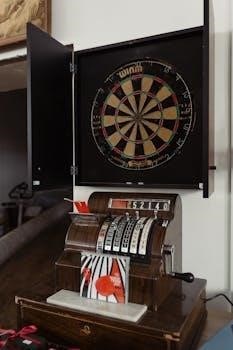over under game manual

The Over Under game blends trivia with a race to the finish line, drawing inspiration from sports betting’s over/under concept. Players can compete individually or in teams, adding a layer of strategy and knowledge to the gameplay.
What is the Over Under Game?
The Over Under game is a unique combination of trivia and strategy, where participants aim to be the first to reach the finish line. It borrows the ‘over/under’ concept from sports wagering, but applies it to the realm of trivia. Players or teams navigate a game board, answering questions to progress. A die roll determines if a team moves forward or backward, adding an element of chance. The game can accommodate individual players or up to four teams, and requires a mix of knowledge and tactical thinking. The rules may vary, with some versions including house rule adaptations. This interactive game is not just about answering correctly, but also about making strategic decisions regarding movement and risk. It’s a versatile game that appeals to diverse age groups and provides opportunities for both competitive and casual play, where a basic understanding of the game mechanics will allow for a more comprehensive play.

Game Components and Setup
To begin playing the Over Under game, you’ll need a game board, player pawns, a die, and trivia cards. The playing area should be designated with a clear start and finish line.
Required Materials for Over Under
To fully enjoy a game of Over Under, you’ll need a few essential components. First, a game board marked with a clear path, including a start and finish line, is necessary. Player pawns or tokens, allowing each player or team to track their progress, are also crucial. A standard six-sided die is used to determine movement and actions during the game. A stack of trivia cards, each containing a question with a numerical answer for over/under guessing, is a must-have. Additionally, a rulebook or game manual is needed for reference, especially when players have questions or clarifications on specific gameplay aspects or potential variations of the game. Finally, if playing in teams, each team should have their own pawn or token.
Setting up the Playing Area
Setting up the playing area for Over Under is straightforward but important for smooth gameplay. Begin by placing the game board on a flat, stable surface where all players can easily reach it. Ensure there is adequate space around the board for players to move their pawns and for the stack of trivia cards and the die. If playing in teams, arrange the players so each team can see the board and easily discuss answers. If playing individually, organize players around the board in a comfortable manner. Keep the rulebook accessible for quick reference. The start and finish lines should be clearly visible. Pawns are placed at the designated starting area, ready for the first roll of the die.

Gameplay Mechanics
The core of Over Under revolves around dice rolls, pawn movement, and trivia challenges. Players advance or retreat based on the die, aiming to reach the finish by answering questions accurately.
Turn Structure in Over Under
A player’s turn in Over Under begins with rolling a die. This die roll determines the course of action for the turn, either advancing or retreating two spaces. Following the die roll, the player must tackle a trivia question. The player will present the trivia question to other players. If a player answers the question accurately and chooses correctly, they win the card, ending their turn. If they are incorrect, the card is placed back in the box, and the turn is over; The stack of cards is passed to the left, making the next player the question master, in a circular manner. This structure promotes continuous engagement and strategic decision-making.
Moving Pawns and Scoring
In the Over Under game, pawn movement is directly linked to the roll of a die. The result of the die roll dictates whether a player moves their pawn forward or backward two spaces on the game board. This movement is not just random but is intertwined with the trivia questions. Successfully answering the trivia question and choosing “over” or “under” correctly will allow players to proceed along the board. The scoring system is based on the number of trivia cards won. Each correct answer and prediction helps players accumulate cards. The first player or team to reach the finish line by strategically using both movement and trivia skill is declared the winner.
Trivia Questions and Answers
The core of the Over Under game revolves around a deck of trivia cards, each containing a question and a numerical answer. Players are presented with a question and must estimate whether the actual answer is “over” or “under” a certain value. These questions span various topics, ensuring a diverse challenge for all participants. The trivia cards are designed to test a broad spectrum of knowledge. Once a player makes their over/under prediction and answers the question, the correct answer is revealed. A successful prediction and answer allows a player to move their pawn forward. However, an incorrect prediction would require the player to move backward. This combination of trivia and prediction is the heart of the game.

Variations and Adaptations
The Over Under game allows for diverse play styles, including team-based or individual challenges. Adaptations for different age groups can be made, and house rules further personalize the game, enhancing overall enjoyment.
Team Play vs. Individual Play
The Over Under game offers two primary modes of engagement⁚ team-based competition and individual play. In team play, participants collaborate, sharing the responsibility of answering trivia questions and moving their pawn. This fosters communication and strategic planning amongst team members. Conversely, individual play places the onus entirely on the single player, demanding independent knowledge and decision-making skills. The choice between team and individual play significantly impacts the social dynamic of the game, with teams encouraging collaborative learning, while individual play promotes a more focused and competitive experience. Both modes contribute uniquely to the overall gameplay, catering to different preferences and fostering varied skill sets. The team mode is good for social gatherings while individual is good for practicing alone.
Modifications for Different Age Groups
Adapting the Over Under game for various age groups requires careful consideration of the trivia questions and complexity of the gameplay. For younger children, simplified questions, focusing on basic knowledge and easily understandable concepts, are essential. The game’s mechanics might also need adjustment, such as reducing the number of spaces on the board or simplifying the scoring system. Conversely, for older players, the trivia can be more challenging, incorporating intricate facts and requiring deeper understanding. The game’s rules can be made more complex and strategic to engage this demographic, allowing for a more advanced and rewarding gameplay experience. By tailoring the game’s elements, Over Under can be enjoyable and educational for all ages, promoting inclusive play.
House Rules and Customizations
The beauty of the Over Under game lies in its adaptability, allowing for numerous house rules and customizations to enhance the playing experience. Players can introduce variations to the movement of pawns, such as adding special spaces that trigger different actions or consequences. Some groups may choose to adjust the scoring system, awarding additional points for specific trivia question categories or implementing a penalty for incorrect answers. Furthermore, the trivia questions themselves can be tailored to a group’s specific interests, such as focusing on a particular genre or theme. The possibilities are endless, enabling each group to create their own unique and engaging version of the Over Under game. These customizations ensure that the game remains fresh and exciting, fostering replayability and a sense of ownership among players.
Advanced Strategies and Tips
Mastering the Over Under game requires more than just luck; it involves strategic pawn movement and effective trivia answering techniques. Anticipating opponents’ moves and leveraging knowledge are vital for success.
Effective Trivia Answering Techniques
Excelling in the trivia aspect of the Over Under game requires a blend of knowledge and strategic thinking. Players should familiarize themselves with a broad range of topics to increase their chances of answering correctly. When faced with a question, consider the likelihood of various answers. If unsure, try to eliminate clearly incorrect options. Time management is crucial; avoid getting bogged down on difficult questions. It is important to assess the risk of each question and how it relates to your pawn position, choosing to pass if the risk outweighs the reward. Developing a collaborative strategy with your team can also significantly improve overall performance, especially in team-based play. Remembering past questions can also provide insights into the question patterns and the types of answers that the game tends to favor. Always remain calm and focused.
Strategic Pawn Movement
Mastering pawn movement in the Over Under game is crucial for victory. Understanding the implications of moving forward or backward is key. A strategic player considers not only the immediate move but also how it sets up the next few turns. Sometimes, moving backward can be beneficial, positioning the pawn for a better scoring opportunity or avoiding a potential setback. Players should analyze the board, identifying advantageous spaces and pitfalls to avoid. It’s also important to track your opponents’ positions, anticipating their moves and adjusting your strategy accordingly. Risk assessment is vital; sometimes, a more cautious approach is better. The use of dice adds an element of uncertainty, but a well-planned strategy minimizes the impact of unfavorable rolls. Think several steps ahead and carefully choose when to advance or retreat, rather than just acting randomly.

Official Resources and Community
For the official rulebook and game details, refer to the provided manual. Online forums and communities offer discussions, strategies, and rule clarifications, fostering a collaborative learning environment for players.
Where to Find the Official Rulebook
The official rulebook for the Over Under game is typically found within the game’s packaging, often included as a printed booklet. However, in cases where the physical copy is missing or unavailable, the digital version of the rulebook can be located on the game publisher’s official website. This website serves as a primary resource for all game-related information, offering up-to-date rules, clarifications, and any necessary errata. In addition, some online retailers who sell the game may also provide a downloadable PDF version of the manual on their product pages. Furthermore, fan-created resources or dedicated communities might offer links to the official rulebook. It’s crucial to ensure the source is verified and reliable to avoid using outdated or inaccurate versions of the rules. Always consult the official website for the most current and comprehensive version of the Over Under game rules.
Community Forums and Online Discussions
For the Over Under game, numerous online communities and forums exist where players can engage in discussions and share experiences. These platforms offer a space to ask questions about the rules, clarify any ambiguities, or discuss strategies and house rules; Dedicated forums on platforms like Reddit, or specific gaming websites, often host threads focused on the Over Under game, allowing players to connect with others who share their interest. Additionally, some online game servers or fan pages may have active discussion sections. These online communities provide a fantastic opportunity to learn from experienced players, share your own insights, and stay up-to-date on any game-related news or rule clarifications. They also allow players to connect with others from around the world, fostering a sense of community and shared excitement for the game. Remember to participate respectfully and constructively in these discussions.